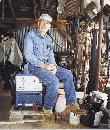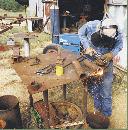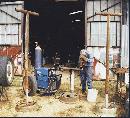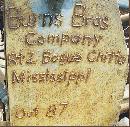
Scrap metal, Miller welders and innovative thinking Help this “country welder” keep his farm running smoothly
By John Leisner, product manager, Miller Electric Mfg. Co.
A little imagination and a welding machine go a long way to keep the Burns Brothers Farms running. Frank Burns, 74, and brother Robert manage 1,000 acres of land in Bogue Chitto, Miss. A self-described “country welder with a voracious appetite for steel,” Frank handles all the maintenance, repair and construction project work by himself. In fact, one cannot set foot on the farm without noticing his practical welding creations. This includes a modified fork on the Ford tractor to lift logs, a log splitter powered by the power take-off unit of an old tractor and the hydraulic arm of a scrapped bulldozer, a toolbox mounted on the front of a trailer (of course, the trailer was made by chopping off the bed of an old truck and welding on a hitch), a lumber rack and a press brake to bend galvanized sheet metal roofing.
“Those little welding projects are just all over the place. Every one of them is kind of unique, one-of-a-kind, never to be seen again,” Frank said. The only repeat projects are his high power rifle barrels, made under the name of Hog Chain Armory, and the armory is really just the sprawling work shed that houses lathes, mills, saws, welders, sandblasters, smelters, air compressors and hundreds of tools.
Frank graduated from Louisiana State University in 1949 with a mechanical engineering degree and served as a second lieutenant in the Army as a Combat Engineer during the Korean War. After his hitch ended, Frank and his brother started out in the cattle business. When that industry dried up, they moved on to raising hay and Pensacola Bahia grass seed and seed for crimson clover, arrow leaf clover and ball clover in the late 1960s. Tired of the effort and mess of seed farming and seeing the profitability in jackpines, the brothers moved into tree farming. The 250-acre seed and hayfield now serves as 600-yard range for the local rifle club (that, too, required welding, specifically an engine-driven welding generator to weld the target holders and power the saws and drills to build the wooden target frames). With welding demands as diverse as his work history, Frank has developed a sense of inventiveness and efficiency any farmer would appreciate.
The Old Becomes New
Frank looks to his surroundings and uses what is available at the lowest cost, or better yet, free. He has harvested a collection of materials that serve him time and time again. Old oil-field pipe, an abundant find in the South, an old water tower from a near-by small town and a good relationship with junkyard owners provide Frank with the metal he needs to weld unique and cost-effective creations. He also scours equipment sales from companies going out of business.
Frank acquired a woodcutting bandsaw from one such company and transformed it into a metal-cutting bandsaw--breathing life back into wooden-spoke wheels. He used his MIG welder, a Millermatic all-in-one MIG welding system, to weld the flanges for a gear reducer. Originally from an old fertilizer truck spreader, the reducer makes the speed more appropriate for cutting metal. Frank welded a circular flange to the output shaft of the speed reducer and a second flange to the bandsaw shaft. He machined the welds flat on the sides that would mate, then bolted the flanges together to connect the shafts.
Today’s successor to Frank’s MIG welder, the Millermatic® 251, is a farm tool as versatile as he is. With an output power range of 30-300 Amps and a rated output of 250 Amps at 40 percent Duty Cycle, Miller’s all-in-one MIG welder delivers a superior arc when welding 22 gauge up to 1/2 in. steel, and it can also weld aluminum and stainless. Engineered for performance, its Active Arc Stabilizer™ provides the most consistent arc starts in its class along with optimum weld performance on both thin and thick metal.
As the easiest welding process to learn, MIG offers superior welding versatility. The high welding speeds that MIG offers reduces his construction or repair time compared to Stick welding.
For welding high strength steel alloys or thick metals, such as the side plates reinforcing his skidder (a loader with balloon tires to move trees) or oil field pipe, Frank advised other folks to preheat the metal with a torch. Not fooled by the outward good looks of a weld, his own destructive bend tests proved that lack of penetration could result in a break. Preheating helps ensure good fusion because the welding arc does not have to work as hard, and it increases the thickness of the material he can weld.
Welding Tools for the Handyman
Dodging the difficulties that come with moving a heavy and awkward steel workbench, Frank has created a portable welding table (see photo) that he can roll to where the work is (half a dozen machine and storage sheds dot the 45-acre homestead area of the farm).
“All welders should have one like this around their shop,” Burns said. To build the portable table, Frank welded a short section of oil field pipe inside the rim of an old wheel. He then took a coping tool (available at welding supply stores), clamped it over a second section of pipe and traced the template for a saddle using soap stone. After flame cutting the saddle, the second section of pipe literally fits to a T with the section welded to the rim. Frank then welds the two pipe sections together and welds a 2-ft. square section of plate to the top of the second piece. So that he could use the table for flame cutting without damaging it, he cut a 6-in.-square hole in it…the perfect size for the 2 to 4-in. oil field pipe that is his most common material (why buy angle iron when scrap oil field pipe costs less?).
When Frank decided to put an end to a leaky work shed roof problem that had burdened him for years, he constructed a new galvanized steel roof entirely on his own.
“By the time I got through, I could carry tools in each hand and go up that ladder like a monkey,” Frank commented (remember this is a man who purchased a pair of in-line skates at age 73). However, he first needed a way to lift the roofing material, so he again employed old wheel rims and oil field pipe.
Starting out just like his portable welding table, Frank cut a saddle in a 2-3/8-in. diameter, 8-ft.-long section of oil field pipe to create a T-joint with his wheel rim base. To create a vertical slide action with a mechanism to lock the lift in place, he drilled and tapped a hole in a 3-in. diameter, 8-ft.-long section of boiler tubing and used a bolt with a T-handle into the tapped hole. At the top of the larger pipe, he again cuts a saddle to mount a 2-ft.long section of pipe for a platform. After creating two of these slide-lock “jacks,” Frank was able to place his roofing material on the platform and, by lifting one side a foot or so at a time, locking in place and alternating jacks, he “walked” the material up to the roof.
Burns not only uses welding for repair, but as a way to compensate for the stresses that are put on his equipment. To reinforce the ramp on the trailer for his tractor, he welded a 1/4-in. plate to act as a stiffener.
Frank has also created his own stove for smelting lead. A section of 30 in. round, 3/8-in. wall pipe acts as the body. Cutting out a top plate to fit the pipe, he welded it to the top of the stove. However, like all of Frank’s custom creations, the top plate was developed with a touch of insight. Using a hydraulic press with about a 50-ton capacity, Burns gave slight curvature to the lid. This compensates for the expansion and contraction that occurs with heat fluctuation. That 50-ton press is largely home-made, too--give the man a pump, some hydraulic fluid, the ram from an old piece of equipment and some pipe and plate, and he could make one for you, too.
Field Work
Frank, like most any farmer, has had equipment break in the field. But in his case, the old hay and seed field is five miles away from his work shed. Fortunately, with a welding generator in the back of his truck and Stick electrodes in his pocket, Frank fixes the baler in short order.
Farmers like Frank demand compact welding and auxiliary power generators that are both portable and versatile. Miller’s Blue Star® welder generator is designed to meet such demands. With an output range of 40-140 Amps (good enough for a 1/8-in. Stick electrode, the most common size) and weighing just over 200 lb., this welder generator provides 3500 watts, 30 A at 115 V while not welding. Purchased in 1981, Burns has relied on the power, versatility and portability that the Blue Star offers for 21 years.
“This isn’t a crew. It’s just me, by myself,” Frank noted. So how does one man lift a 200-lb. welder-generator by himself? By building his own crane, of course. The materials are four front wheel automobile spindles from an early vintage Plymouth, old oil-field pipe for an A-frame and a World War II bomb hoist that rides along an I-beam. It rolls so easily that Frank can push it with one hand. To roll the Blue Star along the floor, he mounted it on a wood platform and uses (yes, you guessed) pieces of oil field pipe to serve as rollers.
Safety first
After all his years of welding his way to a one-man operation, Burns has learned the importance of safety. He follows the recommendations of welding helmet manufacturers for lens shades and also insists on wearing steel-toe boots.
Frank started wearing soft-toe boots when his safety-toe boots wore out one day. However, as he quickly discovered, ignoring safety precautions has a way of stepping on one’s toes.
“ I stop wearing safety-toed boots, I guarantee within two or three days I’m going to drop a piece of pipe on it,” Burns said. Needless to say, he has worn safety-toe boots ever since.
Safety, however, is not the only factor in Frank’s successful longevity. Creativity over the years has been paramount. Working alone has called for some inventive thinking that Burns admits can be difficult. “Thinking is the hardest thing in the world to do,” Burns said. “People who are lazy about thinking, they’re never going to do anything where it takes a little bit of creativity.” However, creation after creation, Burns has paired his knowledge and skill of welding with innovative thinking--and hundreds of solutions for Burns Bros. Farm.




